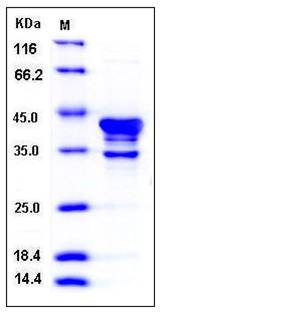Human CAMK1 / CaMKI-alpha Protein
CAMKI
- 100ug (NPP1102) Please inquiry
| Catalog Number | P11932-HNCE |
|---|---|
| Organism Species | Human |
| Host | E. coli |
| Synonyms | CAMKI |
| Molecular Weight | The recombinant human CAMK1 comprises 371 amino acids and has a predicted molecular mass of 41.5 kDa. The apparent molecular mass of the protein is approximately 42 kDa in SDS-PAGE under reducing conditions as predicted. |
| predicted N | Gly |
| SDS-PAGE |  |
| Purity | > 85 % as determined by SDS-PAGE |
| Protein Construction | A DNA sequence encoding the human CAMK1 (NP_003647.1) (Leu 2-Leu 370) was expressed and purified, with two additional amino acids (Gly & Pro) at the N-terminus. |
| Bio-activity | |
| Research Area | Cancer |Signal transduction |Signaling Pathway |Calcium Signaling |Calmodulin / CaMK |
| Formulation | Supplied as sterile 50mM Tirs, 150mM NaCl, 10% glycerol, pH 7.5 1. Normally 5 % - 8 % trehalose and mannitol are added as protectants before lyophilization. Specific concentrations are included in the hardcopy of COA. |
| Background | Calcium/calmodulin-dependent protein kinase or CaM kinases are serine/threonine-specific protein kinases that are primarily regulated by the Calcium/calmodulin complex. These kinases show a memory effect on activation. CaM kinases activity can outlast the intracellular calcium transient that is needed to activate it. In neurons, this property is important for the induction of synaptic plasticity. Pharmacological inhibition of CaM kinases II blocks the induction of long-term potentiation. Upon activation, CaM kinases II phosphorylates postsynaptic glutamate receptors and changes the electrical properties of the synapse. |
| Reference |
